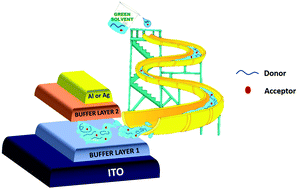Green solvent-processed organic electronic devices
Abstract
Organic electronic FAB factories are hard-pressed due to the current regulatory requirements which restrict (or ban) the use of hazardous solvents; on the other hand, toxic halogenated (or aromatic hydrocarbon) solvents have been the most preferred processing options to date, since they typically enable ideal performance. In this review, we specifically focus on the recent research efforts to process organic semiconductors from green solvents for thin film transistors (TFT) and organic photovoltaics (OPV) applications; the aim is to provide a rationale helping in guiding the safe fabrication of high-performance devices.

- This article is part of the themed collections: Celebrating Tobin Marks’ 75th Birthday and Journal of Materials Chemistry C Recent Review Articles


 Please wait while we load your content...
Please wait while we load your content...